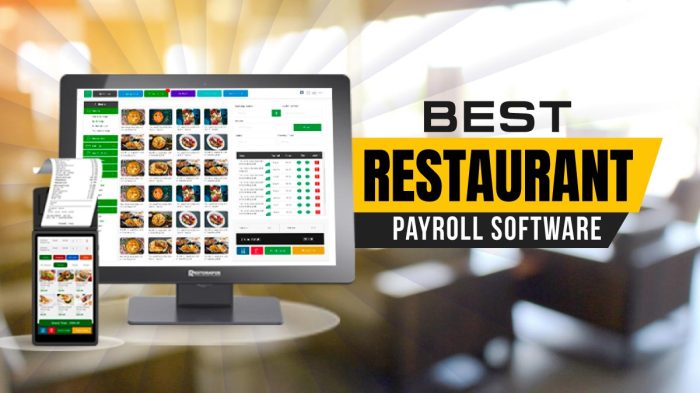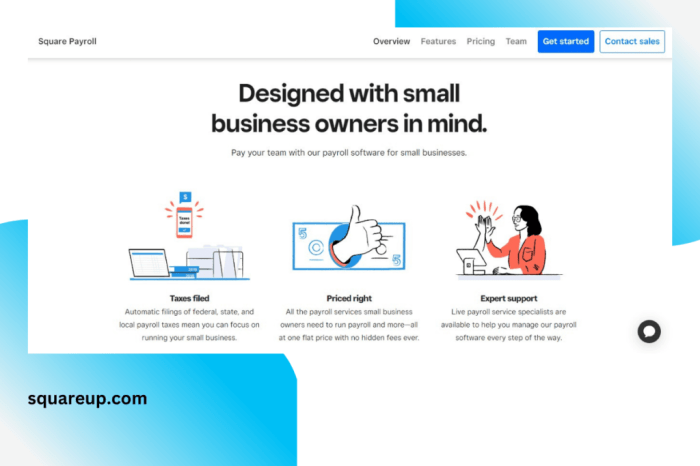
Best Restaurant Payroll Software: Streamline Your Operations
Best restaurant payroll software is a game-changer for busy restaurateurs, simplifying the complex world of payroll and freeing you to focus on what matters most: serving delicious food and creating a memorable dining experience. Gone are the days of manual calculations, time-consuming paperwork, and the potential for costly errors.
With the right restaurant payroll software, you can automate your payroll processes, ensuring accurate and timely payments to your employees while gaining valuable insights into your labor costs.
Imagine a system that seamlessly tracks employee hours, manages tips, calculates taxes, and generates comprehensive reports, all while integrating with your existing point-of-sale (POS) system. This is the power of modern restaurant payroll software, designed specifically to address the unique challenges faced by restaurants.
Whether you’re a small independent eatery or a bustling chain, the right software can revolutionize your payroll management and help you make smarter decisions about your workforce.
Understanding Restaurant Payroll Software
Running a restaurant is a complex endeavor, and managing payroll is a critical aspect that requires accuracy and efficiency. Restaurant payroll software simplifies this process by automating tasks, reducing errors, and providing valuable insights into labor costs.
Key Functionalities of Restaurant Payroll Software
Restaurant payroll software offers a comprehensive set of functionalities designed to streamline payroll processes specific to the hospitality industry.
- Time and Attendance Tracking:Restaurant payroll software integrates with time clocks or mobile apps to accurately record employee hours, including breaks and overtime. This eliminates manual timekeeping, reduces errors, and ensures accurate compensation.
- Tip Management:A key feature of restaurant payroll software is its ability to manage tip distribution. It allows for the tracking and allocation of tips, ensuring compliance with federal and state regulations, and providing employees with accurate tip reports.
- Payroll Calculation and Tax Filing:Restaurant payroll software automatically calculates wages, taxes, and deductions, ensuring compliance with all applicable federal, state, and local regulations. It also handles tax filings, reducing the administrative burden on restaurant owners.
- Employee Self-Service:Many restaurant payroll software solutions offer employee self-service portals, allowing employees to access their pay stubs, update personal information, and submit time-off requests online.
- Labor Cost Analysis:Restaurant payroll software provides detailed labor cost analysis reports, helping restaurant owners track labor expenses, identify areas for cost savings, and make informed decisions about staffing levels.
Features Differentiating Restaurant Payroll Software from General Payroll Solutions
Restaurant payroll software is tailored to the unique needs of the hospitality industry, offering features not typically found in general payroll solutions.
Finding the best restaurant payroll software can be a real headache, especially when you’re juggling menus, customer orders, and staff schedules. But, sometimes a break from the digital world is just what you need. If you’re looking for a creative outlet, why not try how to transfer a photo to wood ?
It’s a fun way to personalize your space and showcase your artistic side. Once you’ve got your creative juices flowing, you can come back to the task of choosing the perfect payroll software for your restaurant.
- Tip Tracking and Allocation:Restaurant payroll software handles tip tracking and allocation, ensuring compliance with federal and state tip regulations. This includes calculating tip credits, tracking tip pooling arrangements, and providing employees with accurate tip statements.
- Shift Scheduling and Labor Management:Some restaurant payroll software solutions integrate with scheduling tools, allowing restaurant owners to create and manage employee schedules, track labor costs, and optimize staffing levels based on predicted demand.
- Food and Beverage Cost Tracking:Restaurant payroll software can integrate with point-of-sale (POS) systems to track food and beverage costs, providing insights into menu pricing, ingredient usage, and potential cost savings.
- Compliance with Industry-Specific Regulations:Restaurant payroll software is designed to comply with specific labor laws and regulations applicable to the hospitality industry, such as the Fair Labor Standards Act (FLSA) and state-specific tip regulations.
Examples of How Restaurant Payroll Software Simplifies Tasks
- Tip Management:Instead of manually calculating and distributing tips, restaurant payroll software automatically tracks tip income, applies tip credits, and allocates tips to employees based on pre-defined rules. This eliminates the potential for errors and ensures accurate tip distribution.
- Time Tracking:Restaurant payroll software integrates with time clocks or mobile apps, allowing employees to clock in and out electronically. This eliminates the need for manual time sheets, reduces the risk of errors, and provides accurate records of employee hours worked.
- Labor Cost Analysis:Restaurant payroll software provides detailed reports on labor costs, including hourly wages, overtime pay, and benefits. This information helps restaurant owners identify areas where they can reduce labor expenses, optimize staffing levels, and improve profitability.
Benefits of Using Restaurant Payroll Software

Restaurant payroll software is a game-changer for busy restaurants. It streamlines payroll processes, reduces errors, and helps you optimize labor costs. This translates into more time for what matters most – serving delicious food and creating memorable experiences for your customers.
Improved Accuracy and Reduced Errors
Payroll errors can be costly and time-consuming. Restaurant payroll software eliminates manual calculations and minimizes the risk of human error. It automatically calculates wages, deductions, and taxes, ensuring accurate and timely payments to your employees.
For example, a restaurant using manual payroll might miscalculate overtime hours, leading to underpayment or overpayment. Restaurant payroll software eliminates this risk by accurately tracking employee hours and applying the correct overtime rates.
Time Savings and Efficiency
Restaurant payroll software automates repetitive tasks, freeing up your time to focus on other aspects of your business. You can say goodbye to manually entering employee information, calculating hours, and generating paychecks.
- Automated Time Tracking:Restaurant payroll software integrates with time and attendance systems, allowing employees to clock in and out electronically. This eliminates the need for manual timekeeping and reduces the risk of time theft.
- Simplified Tax Compliance:Restaurant payroll software keeps you compliant with all federal, state, and local tax regulations. It automatically calculates and files payroll taxes, reducing the risk of penalties and fines.
- Faster Paycheck Processing:Restaurant payroll software streamlines the paycheck process, ensuring employees receive their paychecks on time and accurately.
Optimized Labor Costs
Restaurant payroll software helps you manage labor costs effectively. It provides real-time insights into labor expenses, allowing you to identify areas for improvement.
- Labor Cost Tracking:Restaurant payroll software provides detailed reports on labor costs, including hourly wages, overtime, and benefits. This information helps you identify areas where you can reduce costs, such as optimizing scheduling and minimizing overtime.
- Budgeting and Forecasting:Restaurant payroll software helps you create accurate labor budgets and forecasts. This allows you to make informed decisions about staffing levels and ensure that you are not overspending on labor costs.
Enhanced Employee Satisfaction
Restaurant payroll software contributes to employee satisfaction by ensuring timely and accurate paychecks. It also provides employees with self-service options, such as accessing pay stubs and updating personal information online.
For example, a restaurant using payroll software can offer employees access to a secure online portal where they can view their pay stubs, update their contact information, and access other important documents. This empowers employees and improves their overall experience.
Finding the best restaurant payroll software can be a real game-changer, especially with all the complexities of managing staff in the hospitality industry. I just read some exciting news from Laura exciting news from laura about a new payroll software that seems perfect for restaurants.
It seems like it could be the answer to all my payroll headaches, so I’m definitely going to check it out! I’ll let you know what I think once I’ve had a chance to play around with it.
Key Features to Consider
When selecting restaurant payroll software, it’s crucial to evaluate the features that align with your specific needs and operational requirements. The right software can streamline payroll processes, reduce errors, and provide valuable insights into your workforce.
Comparison of Essential Features
To aid your decision-making, here’s a table comparing the essential features of popular restaurant payroll software solutions:| Feature | Description | Benefits ||—|—|—|| Time Tracking| Enables employees to clock in and out, track their hours worked, and record breaks. | Accurate time tracking ensures employees are paid correctly and helps identify overtime hours.
|| Scheduling| Allows managers to create and manage employee schedules, assign shifts, and track attendance. | Efficient scheduling optimizes labor costs and reduces staffing shortages. || Tip Management| Facilitates the tracking and distribution of tips, ensuring compliance with labor laws. | Streamlined tip management ensures accurate tip calculations and eliminates disputes.
|| Reporting| Provides comprehensive insights into payroll data, including labor costs, overtime hours, and employee performance. | Data-driven reporting helps identify areas for improvement, optimize staffing, and manage costs effectively. || Integration with POS Systems| Connects payroll software with your point-of-sale system, automating data transfer and reducing manual entry.
| Inte
Finding the best restaurant payroll software can be a game-changer for your business, streamlining processes and freeing up your time. While you’re sorting out your finances, take a break and check out discover fresh styles dagmars denim restocked for some fresh fashion inspiration.
Once you’re back to the task at hand, you’ll be ready to choose the payroll system that perfectly suits your restaurant’s needs.
gration eliminates the need for manual data entry, minimizing errors and saving time. || Mobile Accessibility| Allows employees to access payroll information and manage their schedules from their mobile devices. | Mobile accessibility empowers employees to stay informed and manage their work schedules conveniently.
|
Choosing the Right Software: Best Restaurant Payroll Software

Selecting the right restaurant payroll software is crucial for ensuring efficient and accurate payroll processing, minimizing compliance risks, and ultimately, maximizing your restaurant’s profitability. This decision involves carefully considering various factors, including your restaurant’s size, budget, specific needs, and integration requirements.
Factors to Consider
When choosing restaurant payroll software, it’s essential to evaluate several factors to ensure the software aligns with your restaurant’s unique requirements.
- Restaurant Size:The size of your restaurant directly influences your payroll needs. Smaller restaurants with a limited number of employees may benefit from simple, user-friendly software, while larger restaurants with multiple locations and a complex workforce might require more robust solutions with advanced features.
- Budget:Payroll software solutions come with varying price tags. It’s essential to determine your budget and explore options that offer the best value for your investment. Consider factors like monthly fees, per-employee costs, and additional charges.
- Specific Needs:Every restaurant has unique needs. For example, if your restaurant operates with a large number of tipped employees, you’ll need software that accurately calculates and tracks tip reporting and compliance with relevant labor laws.
- Integration Requirements:Consider the integration needs of your restaurant’s existing systems. You might need software that seamlessly integrates with your point-of-sale (POS) system, time and attendance tracking software, or other critical business applications.
Researching Software Providers
Once you’ve identified your key requirements, it’s time to research different software providers. This research should involve:
- Feature Comparison:Compare the features offered by different providers, ensuring they meet your specific needs. Consider features like payroll processing, tax calculations, time and attendance tracking, employee onboarding, and reporting capabilities.
- Pricing Comparison:Carefully analyze the pricing models of various providers. Compare monthly fees, per-employee costs, and any additional charges for features or support. Some providers offer free trials or demos, allowing you to test the software before committing.
- Customer Support Evaluation:Customer support is crucial for any software solution. Research providers’ customer support options, including phone, email, live chat, and online resources. Look for providers with responsive and knowledgeable support teams.
- User Reviews and Testimonials:Reading user reviews and testimonials can provide valuable insights into the strengths and weaknesses of different software solutions. Look for reviews that address factors important to your restaurant, such as ease of use, accuracy, and customer support.
Pricing Models
Restaurant payroll software providers offer various pricing models, each with its own advantages and disadvantages. Here’s a comparison of some popular pricing models:
| Software Provider | Monthly Fee | Per-Employee Cost | Additional Charges |
|---|---|---|---|
| Paychex | $49
|
$4
|
Optional add-ons for features like time and attendance tracking |
| ADP | $49
|
$4
|
Optional add-ons for features like time and attendance tracking |
| Gusto | $40
|
$6
|
Optional add-ons for features like time and attendance tracking |
| Homebase | $25
|
$0
|
Optional add-ons for features like time and attendance tracking |
Note:Pricing may vary depending on the number of employees, features, and other factors. It’s always recommended to contact the software provider directly for the most up-to-date pricing information.
Implementation and Training

The implementation of restaurant payroll software involves a series of steps to ensure a smooth transition and minimize disruption to restaurant operations. A successful implementation requires careful planning, effective communication, and ongoing support.
Data Migration, Best restaurant payroll software
Data migration is a crucial step in the implementation process. It involves transferring existing employee and payroll data from your current system to the new software. This process can be complex, especially if you have a large number of employees or a history of payroll data.
- Prepare Your Data:Before migrating data, ensure it is accurate and complete. Clean up any inconsistencies or errors to prevent issues during the transfer.
- Choose a Migration Method:You can migrate data manually, using spreadsheets or import files, or through a dedicated data migration tool. Consider the volume of data and the complexity of your current system when choosing a method.
- Test the Migration:After migrating data, test the software thoroughly to ensure accuracy and completeness. Verify that all employee information, payroll records, and tax data are transferred correctly.
User Training
Proper training is essential to ensure your staff can effectively use the new payroll software. It’s important to provide training that is tailored to the specific needs of your restaurant.
- Identify Key Users:Determine the individuals who will be responsible for using the software, such as managers, supervisors, and payroll administrators.
- Provide Comprehensive Training:Offer training on all aspects of the software, including data entry, payroll processing, reporting, and compliance.
- Offer Ongoing Support:Provide ongoing support after the initial training, including access to online resources, FAQs, and dedicated support personnel.
System Integration
Restaurant payroll software should integrate seamlessly with your existing systems, such as point-of-sale (POS) systems, time and attendance systems, and accounting software. This integration streamlines payroll processes and reduces the risk of errors.
- Identify Integration Points:Determine the systems that need to be integrated with the payroll software.
- Choose Integration Methods:Explore different integration methods, such as API connections, data files, or cloud-based platforms.
- Test the Integration:After integrating systems, test the data flow and functionality to ensure accuracy and efficiency.
Tips for a Smooth Transition
- Plan Ahead:Start planning for the implementation early to allow sufficient time for data migration, training, and testing.
- Communicate Effectively:Keep your staff informed about the implementation process, including timelines, training schedules, and any changes to their responsibilities.
- Provide Support:Offer ongoing support to your staff during the transition period, addressing any questions or concerns they may have.
- Start Small:If possible, start with a pilot group of employees to test the software and identify any potential issues before rolling it out to the entire restaurant.
Ongoing Support and Training
Even after the initial implementation, it’s crucial to provide ongoing support and training to maximize the benefits of the software.
- Offer Regular Updates:Keep your staff informed about new features, updates, and changes to the software.
- Provide Ongoing Training:Offer periodic training sessions to refresh employees’ knowledge and address any new challenges.
- Monitor Software Usage:Track software usage to identify areas where employees may need additional support or training.


